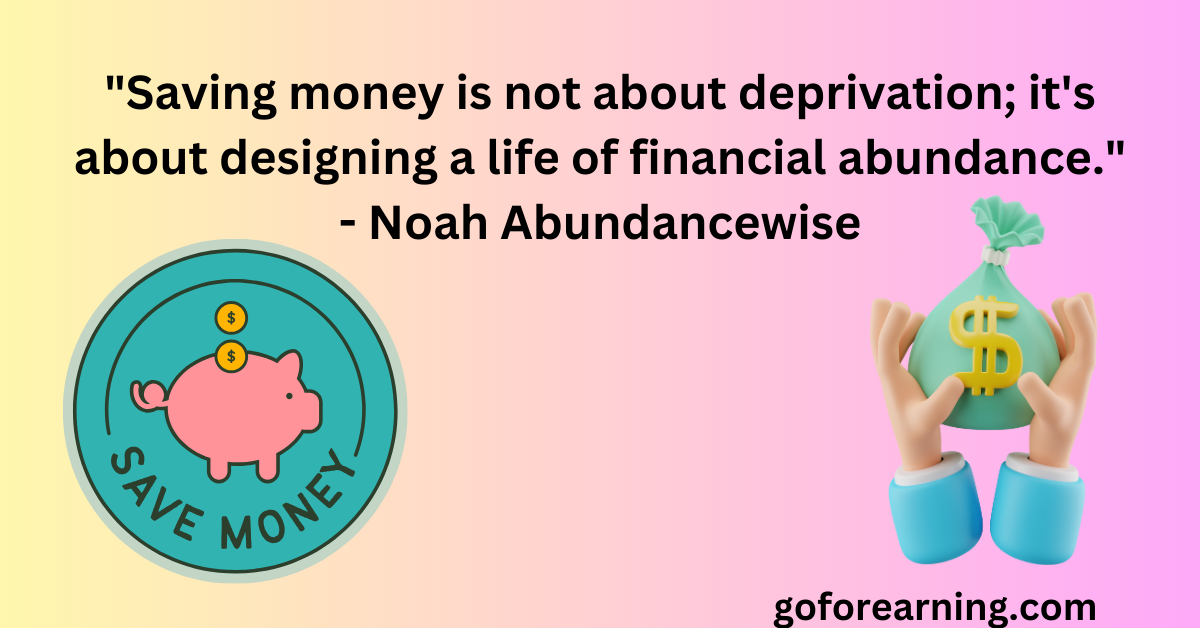Discover the secrets of financial growth with our journey through ‘How Savings Accounts Earn Interest.'” Consider your money working for you, automatically growing as you go about your day. In this investigation, we look at the interesting world of savings accounts and the chemistry underlying interest collection. Discover the power of compounding, the secret method that turns your money into an excellent financial asset. Join us on an exciting journey where your money is not only saved but deliberately multiplied, paving the road for a greater, more wealthy future. Prepare to transform your perception of savings and start on a journey to financial prosperity.
“Money saved is the shield that protects you from financial storms. Fortify wisely.” – Emma Fortifywise
Introduction
Saving money is more than simply a good financial move; it is the foundation of financial security. In this blog article, we will dig into the fascinating world of savings accounts, with an emphasis on one critical feature that many people still don’t understand: generating interest. Let us look at the importance of this often-overlooked area in personal finance.

Understanding Savings Accounts
Definition and Basic Functions
Before we go into the complexity of interest, let’s lay the groundwork. A savings account is a financial instrument used to protect and develop your money. Unlike checking or investment accounts, savings accounts strike a balance between convenience and security. It serves as a financial buffer, ensuring that your cash are easily accessible when required.
Comparison with Other Types of Accounts
Now, why should you pick a savings account over other options? The solution lies in the balance between accessibility and security. While investing accounts may provide larger rewards, they also carry inherent dangers. A savings account, on the other hand, offers a secure safety for your money, allowing you to access it whenever you need it without the volatility associated with investing.
How Interest Works in Savings Accounts
Savings accounts are deposit accounts provided by banks and other financial organizations. One of the primary benefits of savings accounts is that they produce interest, allowing account holders to watch their money increase over time. Here’s an example of how savings accounts generate interest:
How Savings Accounts Earn Interest: Explaining the Concept of Interest
1. Interest Rate:
- Savings accounts have an interest rate, which is the proportion of the account amount paid as interest over a certain period (often yearly, but may also be monthly or quarterly).
2. Compounding:
- Interest may be either simple or compounded. Compounding implies that interest is computed on both the original deposit and the interest that has already been contributed to the account. This causes the money to accrue interest over time, resulting in quicker growth.
3. Example:
- Let’s say you have $1,000 in a savings account with an annual interest rate of 3%, compounded annually.
- At the end of the first year, you would earn $30 in interest (3% of $1,000).
- The new account balance at the end of the year would be $1,030.
- In the second year, the interest is calculated not just on the initial $1,000 but on the new balance of $1,030. So, the interest for the second year would be $30.90 (3% of $1,030).
- The new account balance at the end of the second year would be $1,060.90.
- This process continues, and the interest compounds on the updated balance each year.
4. Formula for Compound Interest:
- The formula for compound interest is: A=P(1+r/n)nt
- Where:
• A represents the future worth of the investment or loan, including interest.
• P represents the primary amount (first deposit).
• The yearly interest rate (r) is expressed as a decimal.
• The term “n” refers to the number of times interest is compounded annually.
• The term “t” refers to the duration of an investment or loan.
Understanding how interest is calculated allows account holders to make more educated choices about where to invest their money for maximum growth. Keep in mind that interest rates and compounding frequency may change across savings accounts and banking organizations.
Differentiating Between Simple and Compound Interest
Now, let’s get into the specifics of interest. There are two main forms of interest: simple and compound. Simple interest is computed on the original deposit, while compound interest includes both the main and the cumulative interest. The latter has the potential for exponential development, making it a popular option among long-term savers.
Importance of Interest in Growing Savings Over Time
Interest is more than simply a gift; it is the motor that drives your savings ahead. Over time, compounding may greatly increase your original contribution, resulting in a snowball effect. This is the secret ingredient for accumulating significant money with the modest savings account.
“Saving money is not a task; it’s a journey towards financial empowerment.” – Liam Empowerwise
Required Documents
List of Documents or Prerequisites
Opening a savings account is not as easy as going into a bank. To get started, you’ll need a few papers such as evidence of identification, residence, and, in certain cases, employment. It is critical to verify with your preferred bank to determine their exact criteria.
Tips on Choosing the Right Bank
Not all banks are created equal, particularly in terms of interest rates. To secure the best interest rates, check the bank’s reputation, fees, and service accessibility. Make your money work for you.
Is It Possible to Earn Interest with Any Savings Account?
Variations in Interest Rates Among Banks
This is when the story deepens. Not every savings account offers the same interest rate. Some banks provide greater interest rates to encourage depositors, while others may give modest returns. Researching and comparing interest rates is an important step toward optimizing your profits.
Impact of Account Balance on Interest Earnings
Surprisingly, the size of your account does impact. A bigger account balance often translates into higher interest rates. Banks reward dedication, so keep a healthy balance for best results.
Can You Control the Interest Rate?
Factors Influencing Savings Account Interest Rates
While you cannot control interest rates, knowing the elements that influence them can empower you. Economic circumstances, central bank policy, and the bank’s financial stability all play important roles. Stay informed to anticipate changes.
Tips on Negotiating or Maximizing Interest Rates
Believe it or not, negotiating is still an option. If you are a loyal client with a large amount, don’t be afraid to talk rates with your bank. Loyalty may come with benefits, like a higher interest rate.
Why You Should Consider a High-Interest Savings Account
Benefits of Choosing a High-Interest Savings Account
Choosing a savings account with a higher interest rate involves more than just numbers. It is a deliberate approach that increases the advantages of saving. Higher interest rates result in greater returns, which contribute significantly to your financial objectives.
Real-Life Examples of How Interest Impacts Savings
Let’s put theory into practice using real-world examples. Consider two savers: one with a conventional interest rate and the other with a high-interest account. Over time, the gap in savings growth becomes clear. Your savings account decision might have a significant impact on your financial destiny.
Also read: The Art of Saving: Expert Financial Tips for Smart Saving
Ways to Maximize Interest Earnings
Strategies for Increasing Overall Interest Earned
Maximizing interest is more than just high rates; it is also about smart saving. Regular payments, even in little sums, may accumulate dramatically over time. Adopting disciplined savings practices is your passport to high interest profits.
Importance of Consistent Contributions
Consistency is essential. Whether you donate monthly or quarterly, the important is to remain committed. Treat your savings as a financial obligation, and your interest profits will skyrocket.
Methods for Monitoring Interest Growth
Tools or Apps for Tracking Interest Growth
In the digital era, it has never been simpler to track your interest increase. Use financial tools and applications that provide insight into your savings path. Seeing your money work for you in real time may be quite motivating.
Setting Up Realistic Goals for Savings Account Growth
Goal-setting isn’t only for fitness aficionados; it’s also an effective tool for personal budget management. Set reasonable savings goals and monitor your success. Having a specific destination makes the trip more fulfilling.
Conclusion
As we conclude this thorough guide, keep in mind that your savings account is more than simply a location to save money; it is also a dynamic instrument for financial progress. Understanding how interest works, selecting the correct account, and keeping up to date on financial trends can put you on the right track to financial success. Happy saving!
Also read: How to Save Money: Top 25 the best tips for Building Your Savings
FAQs
It's best to evaluate your savings account at least once a year. Check for changes in interest rates and fees, and consider moving to a higher-interest account if one becomes available. Yes, you can. If you have a large amount or have been a client for a long time, talk to your bank about interest rates. They may be willing to negotiate. No, high-interest savings accounts are available for a variety of balance amounts. While greater sums often produce higher rates, even little savers might profit from higher interest alternatives. The average interest rate for savings accounts varies, although it often runs between 0.5% and 4% yearly. Rates may be impacted by economic situations, bank policy, and account kinds. Assets accounts are normally considered low-risk, but inflation may diminish the true value of your assets over time. However, unlike investments, the principle balance in a savings account stays protected. Interest on savings accounts is typically compounded weekly, however this might vary by bank. Some may compound quarterly or yearly. The higher the frequency of compounding, the more interest you might possibly earn. Because of their decreased administrative expenses, online banks sometimes offer greater savings account interest rates. They may give a competitive edge, making them an attractive option for individuals looking for higher returns on their money. Withdrawals from savings accounts are permitted; however, certain banks may impose limitations or levy penalties for excessive withdrawals. To improve your savings plan, keep track of any withdrawal limitations and related conditions.How often should I review my savings account for optimal interest?
Can I negotiate interest rates with my bank?
Are high-interest savings accounts only for large balances?
What is the average interest rate for savings accounts?
Can I lose money in a savings account?
How often is interest compounded in savings accounts?
Are online banks better for higher interest rates?
What happens if I withdraw money from my savings account?



